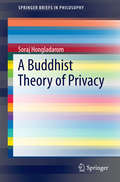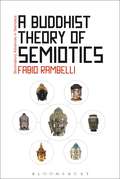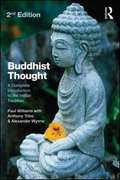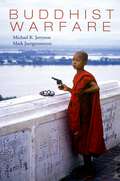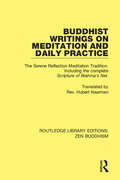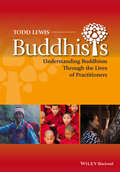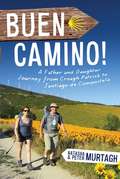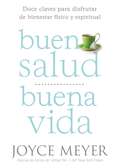- Table View
- List View
A Buddhist Theory of Privacy (SpringerBriefs in Philosophy)
by Soraj HongladaromThis book offers a new way to justify privacy based on a theory derived from Buddhist insights. It uses insights obtained from the Buddhist teachings on Non-Self to create an alternative theory of privacy. In doing so, the author first spells out the inherent differences between the Buddhist insights and the beliefs underlying conventional theories of privacy. While Buddhism views the self as existing conventionally through interactions with others, as well as through interrelations with other basic components, non-Buddhist ideas of self are understood as being grounded upon autonomous subjects, commonly understood to be entitled to rights and dignity. In light of this, the book offers ways in which these seemingly disparate concepts can be reconciled, while keeping in mind the need for protecting citizens’ privacy in a modern information society. It also argues that the new way of conceptualizing privacy, as presented in this book, would go a long way in helping unravel the difficult concept of group privacy.
A Buddhist Theory of Semiotics: Signs, Ontology, and Salvation in Japanese Esoteric Buddhism (Bloomsbury Advances in Semiotics)
by Fabio RambelliOne of the first attempts ever to present in a systematic way a non-western semiotic system. This book looks at Japanese esoteric Buddhism and is based around original texts, informed by explicit and rigorous semiotic categories. It is a unique introduction to important aspects of the thought and rituals of the Japanese Shingon tradition.Semiotic concerns are deeply ingrained in the Buddhist intellectual and religious discourse, beginning with the idea that the world is not what it appears to be, which calls for a more accurate understanding of the self and reality. This in turn results in sustained discussions on the status of language and representations, and on the possibility and methods to know reality beyond delusion; such peculiar knowledge is explicitly defined as enlightenment. Thus, for Buddhism, semiotics is directly relevant to salvation; this is a key point that is often ignored even by Buddhologists. This book discusses in depth the main elements of Buddhist semiotics as based primarily on original Japanese pre-modern sources. It is a crucial publication in the fields of semiotics and religious studies.
A Buddhist Theory of Semiotics: Signs, Ontology, and Salvation in Japanese Esoteric Buddhism (Bloomsbury Advances in Semiotics #2)
by Fabio RambelliOne of the first attempts ever to present in a systematic way a non-western semiotic system. This book looks at Japanese esoteric Buddhism and is based around original texts, informed by explicit and rigorous semiotic categories. It is a unique introduction to important aspects of the thought and rituals of the Japanese Shingon tradition.Semiotic concerns are deeply ingrained in the Buddhist intellectual and religious discourse, beginning with the idea that the world is not what it appears to be, which calls for a more accurate understanding of the self and reality. This in turn results in sustained discussions on the status of language and representations, and on the possibility and methods to know reality beyond delusion; such peculiar knowledge is explicitly defined as enlightenment. Thus, for Buddhism, semiotics is directly relevant to salvation; this is a key point that is often ignored even by Buddhologists. This book discusses in depth the main elements of Buddhist semiotics as based primarily on original Japanese pre-modern sources. It is a crucial publication in the fields of semiotics and religious studies.
Buddhist Thought: A Complete Introduction to the Indian Tradition (2nd edition) (PDF)
by Paul Williams Anthony Tribe Alexander WynneThis book serves as an accessible and reliable survey for students wishing to gain familiarity with the basic ideas of Buddhist philosophical and religious thought, and with some of the recent research in the field. It guides readers towards a richer understanding of the central concepts of classical Indian Buddhist thought, from the time of Buddha to the latest scholarly perspectives and controversies. Abstract and complex ideas are made understandable by the authors' clear and engaging style. The second edition has been fully revised in light of new scholarship, in particular on Mahayana Buddhism and Tantric Buddhism, an often neglected and inadequately understood topic. As well as a detailed bibliography this authoritative resource now includes recommended further reading, study questions, a pronunciation guide and extensive glossary of terms, all aimed at helping students to develop their knowledge and appreciation of Buddhist thought. This book serves as an accessible and reliable survey for students wishing to gain familiarity with the basic ideas of Buddhist philosophical and religious thought, and with some of the recent research in the field. It guides readers towards a richer understanding of the central concepts of classical Indian Buddhist thought, from the time of Buddha to the latest scholarly perspectives and controversies. Abstract and complex ideas are made understandable by the authors' clear and engaging style. The second edition has been fully revised in light of new scholarship, in particular on Mahayana Buddhism and Tantric Buddhism, an often neglected and inadequately understood topic. As well as a detailed bibliography this authoritative resource now includes recommended further reading, study questions, a pronunciation guide and extensive glossary of terms, all aimed at helping students to develop their knowledge and appreciation of Buddhist thought.
Buddhist Thought: A Complete Introduction to the Indian Tradition
by Paul Williams Anthony Tribe Alexander WynneBuddhist Thought guides the reader towards a richer understanding of the central concepts of classical Indian Buddhist thought, from the time of Buddha, to the latest scholarly perspectives and controversies. Abstract and complex ideas are made understandable by the authors' lucid style. Of particular interest is the up-to-date survey of Buddhist Tantra in India, a branch of Buddhism where strictly controlled sexual activity can play a part in the religious path. Williams' discussion of this controversial practice as well as of many other subjects makes Buddhist Thought crucial reading for all interested in Buddhism.
Buddhist Thought: A Complete Introduction to the Indian Tradition
by Paul Williams Anthony Tribe Alexander WynneThis book serves as an accessible and reliable survey for students wishing to gain familiarity with the basic ideas of Buddhist philosophical and religious thought, and with some of the recent research in the field. It guides readers towards a richer understanding of the central concepts of classical Indian Buddhist thought, from the time of Buddha to the latest scholarly perspectives and controversies. Abstract and complex ideas are made understandable by the authors' clear and engaging style. The second edition has been fully revised in light of new scholarship, in particular on Mahāyāna Buddhism and Tantric Buddhism, an often neglected and inadequately understood topic. As well as a detailed bibliography this authoritative resource now includes recommended further reading, study questions, a pronunciation guide and extensive glossary of terms, all aimed at helping students to develop their knowledge and appreciation of Buddhist thought.
Buddhist Thought: A Complete Introduction to the Indian Tradition
by Paul Williams Alexander Wynne Anthony TribeThis book serves as an accessible and reliable survey for students wishing to gain familiarity with the basic ideas of Buddhist philosophical and religious thought, and with some of the recent research in the field. It guides readers towards a richer understanding of the central concepts of classical Indian Buddhist thought, from the time of Buddha to the latest scholarly perspectives and controversies. Abstract and complex ideas are made understandable by the authors' clear and engaging style. The second edition has been fully revised in light of new scholarship, in particular on Mahāyāna Buddhism and Tantric Buddhism, an often neglected and inadequately understood topic. As well as a detailed bibliography this authoritative resource now includes recommended further reading, study questions, a pronunciation guide and extensive glossary of terms, all aimed at helping students to develop their knowledge and appreciation of Buddhist thought.
Buddhist Thought: A Complete Introduction to the Indian Tradition
by Paul Williams Alexander Wynne Anthony TribeBuddhist Thought guides the reader towards a richer understanding of the central concepts of classical Indian Buddhist thought, from the time of Buddha, to the latest scholarly perspectives and controversies. Abstract and complex ideas are made understandable by the authors' lucid style. Of particular interest is the up-to-date survey of Buddhist Tantra in India, a branch of Buddhism where strictly controlled sexual activity can play a part in the religious path. Williams' discussion of this controversial practice as well as of many other subjects makes Buddhist Thought crucial reading for all interested in Buddhism.
Buddhist Understanding of Childhood Spirituality: The Buddha’s Children
by Alexander Von GontardIn this book, Alexander von Gontard, a child psychiatrist, uses the language, thought and imagery of Buddhism to explore the spirituality of children. The book begins by exploring the Buddha's own childhood and the 'divine child' in Buddhism, a key archetype in Jungian psychology. The author defines the spirituality and religiosity of children and adolescents and identifies manifestations of spirituality in children, such as experiences of awe and wonder, and favourable conditions for spirituality, such as silence, nature, extreme conditions and mindfulness. Drawing on his own experience working with children in therapeutic practice, von Gontard discusses the parallels between spontaneous spirituality seen in childhood and the Buddha's teachings. Revealing how the spiritual insights and experiences of children and adolescents can uncover a deep and wise understanding of human life that is compatible with the Buddha's teachings, this book will be of particular interest to professionals and academics in psychology, psychiatry, psychotherapy, education and religious studies.
Buddhist Understanding of Childhood Spirituality: The Buddha’s Children (PDF)
by Alexander Von GontardIn this book, Alexander von Gontard, a child psychiatrist, uses the language, thought and imagery of Buddhism to explore the spirituality of children. The book begins by exploring the Buddha's own childhood and the 'divine child' in Buddhism, a key archetype in Jungian psychology. The author defines the spirituality and religiosity of children and adolescents and identifies manifestations of spirituality in children, such as experiences of awe and wonder, and favourable conditions for spirituality, such as silence, nature, extreme conditions and mindfulness. Drawing on his own experience working with children in therapeutic practice, von Gontard discusses the parallels between spontaneous spirituality seen in childhood and the Buddha's teachings. Revealing how the spiritual insights and experiences of children and adolescents can uncover a deep and wise understanding of human life that is compatible with the Buddha's teachings, this book will be of particular interest to professionals and academics in psychology, psychiatry, psychotherapy, education and religious studies.
Buddhist Warfare
by Michael Jerryson Mark JuergensmeyerThough traditionally regarded as a peaceful religion, Buddhism has a dark side. On multiple occasions over the past fifteen centuries, Buddhist leaders have sanctioned violence, and even war. The eight essays in this book focus on a variety of Buddhist traditions, from antiquity to the present, and show that Buddhist organizations have used religious images and rhetoric to support military conquest throughout history. Buddhist soldiers in sixth century China were given the illustrious status of Bodhisattva after killing their adversaries. In seventeenth century Tibet, the Fifth Dalai Lama endorsed a Mongol ruler's killing of his rivals. And in modern-day Thailand, Buddhist soldiers carry out their duties undercover, as fully ordained monks armed with guns. Buddhist Warfare demonstrates that the discourse on religion and violence, usually applied to Judaism, Islam, and Christianity, can no longer exclude Buddhist traditions. The book examines Buddhist military action in Tibet, China, Korea, Japan, Mongolia, Sri Lanka, and Thailand, and shows that even the most unlikely and allegedly pacifist religious traditions are susceptible to the violent tendencies of man.
Buddhist Warfare
by Mark Juergensmeyer Michael JerrysonThough traditionally regarded as a peaceful religion, Buddhism has a dark side. On multiple occasions over the past fifteen centuries, Buddhist leaders have sanctioned violence, and even war. The eight essays in this book focus on a variety of Buddhist traditions, from antiquity to the present, and show that Buddhist organizations have used religious images and rhetoric to support military conquest throughout history. Buddhist soldiers in sixth century China were given the illustrious status of Bodhisattva after killing their adversaries. In seventeenth century Tibet, the Fifth Dalai Lama endorsed a Mongol ruler's killing of his rivals. And in modern-day Thailand, Buddhist soldiers carry out their duties undercover, as fully ordained monks armed with guns. Buddhist Warfare demonstrates that the discourse on religion and violence, usually applied to Judaism, Islam, and Christianity, can no longer exclude Buddhist traditions. The book examines Buddhist military action in Tibet, China, Korea, Japan, Mongolia, Sri Lanka, and Thailand, and shows that even the most unlikely and allegedly pacifist religious traditions are susceptible to the violent tendencies of man.
The Buddhist World (Routledge Worlds)
by John PowersThe Buddhist World joins a series of books on the world’s great religions and cultures, offering a lively and up-to-date survey of Buddhist studies for students and scholars alike. It explores regional varieties of Buddhism and core topics including buddha-nature, ritual, and pilgrimage. In addition to historical and geo-political views of Buddhism, the volume features thematic chapters on philosophical concepts such as ethics, as well as social constructs and categories such as community and family. The book also addresses lived Buddhism in its many forms, examining the ways in which modernity is reshaping traditional structures, ancient doctrines, and cosmological beliefs.
The Buddhist World (Routledge Worlds)
by John PowersThe Buddhist World joins a series of books on the world’s great religions and cultures, offering a lively and up-to-date survey of Buddhist studies for students and scholars alike. It explores regional varieties of Buddhism and core topics including buddha-nature, ritual, and pilgrimage. In addition to historical and geo-political views of Buddhism, the volume features thematic chapters on philosophical concepts such as ethics, as well as social constructs and categories such as community and family. The book also addresses lived Buddhism in its many forms, examining the ways in which modernity is reshaping traditional structures, ancient doctrines, and cosmological beliefs.
Buddhist Writings on Meditation and Daily Practice: The Serene Reflection Tradition. Including the complete Scripture of Brahma's Net (Routledge Library Editions: Zen Buddhism)
by P. T. N. H. Jiyu-Kennett Daizui MacphillamyThis book, first published in 1994, is a compendium of new translations of certain works regarded as fundamental texts in the Serene Reflection Buddhist Tradition (Sōtō Zen). All the texts were in Chinese, either as original works or as translations from Sanskrit. Several of them are central to the ceremonial not only of the Sōtō Zen Tradition but also of other Mahayana Buddhist traditions as well.
Buddhist Writings on Meditation and Daily Practice: The Serene Reflection Tradition. Including the complete Scripture of Brahma's Net (Routledge Library Editions: Zen Buddhism)
by Hubert NearmanThis book, first published in 1994, is a compendium of new translations of certain works regarded as fundamental texts in the Serene Reflection Buddhist Tradition (Sōtō Zen). All the texts were in Chinese, either as original works or as translations from Sanskrit. Several of them are central to the ceremonial not only of the Sōtō Zen Tradition but also of other Mahayana Buddhist traditions as well.
Buddhists: Understanding Buddhism Through the Lives of Practitioners (Lived Religions)
by Todd LewisBuddhists: Understanding Buddhism through the Lives of Practitioners provides a series of case studies of Asian and modern Western Buddhists, spanning history, gender, and class, whose lives are representative of the ways in which Buddhists throughout time have embodied the tradition. Portrays the foundational principles of Buddhist belief through the lives of believers, illustrating how the religion is put into practice in everyday life Takes as its foundation the inherent diversity within Buddhist society, rather than focusing on the spiritual and philosophical elite within Buddhism Reveals how individuals have negotiated the choices, tensions, and rewards of living in a Buddhist society Features carefully chosen case studies which cover a range of Asian and modern Western Buddhists Explores a broad range of possible Buddhist orientations in contemporary and historical contexts
Buddhists: Understanding Buddhism Through the Lives of Practitioners (Lived Religions)
by Todd LewisBuddhists: Understanding Buddhism through the Lives of Practitioners provides a series of case studies of Asian and modern Western Buddhists, spanning history, gender, and class, whose lives are representative of the ways in which Buddhists throughout time have embodied the tradition. Portrays the foundational principles of Buddhist belief through the lives of believers, illustrating how the religion is put into practice in everyday life Takes as its foundation the inherent diversity within Buddhist society, rather than focusing on the spiritual and philosophical elite within Buddhism Reveals how individuals have negotiated the choices, tensions, and rewards of living in a Buddhist society Features carefully chosen case studies which cover a range of Asian and modern Western Buddhists Explores a broad range of possible Buddhist orientations in contemporary and historical contexts
Buddhists, Hindus and Sikhs in America: A Short History (Religion in American Life)
by Gurinder Singh Mann Paul Numrich Raymond WilliamsBuddhists, Hindus, and Sikhs in America explores the challenges that Asian immigrants face when their religion--and consequently culture--is "remade in the U.S.A." Peppered with stories of individual people and how they actually live their religion, this informative book gives an overview of each religion's beliefs, a short history of immigration--and discrimination--for each group, and how immigrants have adapted their religious beliefs since they arrived. Along the way, the roles of men and women, views toward dating and marriage, the relationship to the homeland, the "brain drain" from Asia of scientists, engineers, physicians, and other professionals, and American offshoots of Asian religions, such as the Hare Krishnas and Transcendental Meditation (TM), are discussed.
Buddhists, Shamans, and Soviets: Rituals of History in Post-Soviet Buryatia (Oxford Ritual Studies Series)
by Justine Buck QuijadaHistory in the Soviet Union was a political project. From the Soviet perspective, Buryats, an indigenous Siberian ethnic group, were a "backwards" nationality that was carried along on the inexorable march towards the Communist utopian future. When the Soviet Union ended, the Soviet version of history lost its power and Buryats, like other Siberian indigenous peoples, were able to revive religious and cultural traditions that had been suppressed by the Soviet state. In the process, they also recovered knowledge about the past that the Soviet Union had silenced. Borrowing the analytic lens of the chronotope from Bakhtin, Quijada argues that rituals have chronotopes which situate people within time and space. As they revived rituals, Post-Soviet Buryats encountered new historical information and traditional ways of being in time that enabled them to re-imagine the Buryat past, and what it means to be Buryat. Through the temporal perspective of a reincarnating Buddhist monk, Dashi-Dorzho Etigelov, Buddhists come to see the Soviet period as a test on the path of dharma. Shamanic practitioners, in contrast, renegotiate their relationship to the past by speaking to their ancestors through the bodies of shamans. By comparing the versions of history that are produced in Buddhist, shamanic and civic rituals, Buddhists, Shamans and Soviets offers a new lens for analyzing ritual, a new perspective on how an indigenous people grapples with a history of state repression, and an innovative approach to the ethnographic study of how people know about the past.
Buddhists, Shamans, and Soviets: Rituals of History in Post-Soviet Buryatia (Oxford Ritual Studies Series)
by Justine Buck QuijadaHistory in the Soviet Union was a political project. From the Soviet perspective, Buryats, an indigenous Siberian ethnic group, were a "backwards" nationality that was carried along on the inexorable march towards the Communist utopian future. When the Soviet Union ended, the Soviet version of history lost its power and Buryats, like other Siberian indigenous peoples, were able to revive religious and cultural traditions that had been suppressed by the Soviet state. In the process, they also recovered knowledge about the past that the Soviet Union had silenced. Borrowing the analytic lens of the chronotope from Bakhtin, Quijada argues that rituals have chronotopes which situate people within time and space. As they revived rituals, Post-Soviet Buryats encountered new historical information and traditional ways of being in time that enabled them to re-imagine the Buryat past, and what it means to be Buryat. Through the temporal perspective of a reincarnating Buddhist monk, Dashi-Dorzho Etigelov, Buddhists come to see the Soviet period as a test on the path of dharma. Shamanic practitioners, in contrast, renegotiate their relationship to the past by speaking to their ancestors through the bodies of shamans. By comparing the versions of history that are produced in Buddhist, shamanic and civic rituals, Buddhists, Shamans and Soviets offers a new lens for analyzing ritual, a new perspective on how an indigenous people grapples with a history of state repression, and an innovative approach to the ethnographic study of how people know about the past.
Buddho
by Ajahn Tate Thanissaro BhikkhuA simple and practical guide to the use of the meditation phrase buddho, which is used to settle the mind to the point at which discernment can begin to arise.
Buen Camino! Walk the Camino de Santiago with a Father and Daughter: A Physical Journey that Became a Spiritual Transformation
by Peter Murtagh Natasha MurtaghHave you ever dreamed about walking the Camino de Santiago? Join Peter Murtagh, acclaimed Irish journalist, and his teenage daughter Natasha on their epic pilgrimage across the Way of St James and experience their life-changing adventure with them.If you’ve ever wondered what a hike of 900 miles involves, physically and emotionally, look no further than Buen Camino! You will be transported to Northern Spain, to bull-running and fiestas, to prayers and ancient Christian churches, to a gruelling trek that leads to a spiritual transformation. You’ll meet a motley crew of Camino pilgrims, stay with Peter and Natasha in Spartan hostels, learn about the history of the Camino and, above all, laugh and cry with a loving father and daughter as they walk steps trod by thousands of religious travellers before them.Whether you’re a seasoned ‘peregrino’ seeking to relive your glorious Camino days, a Camino novice looking for stories of Camino veterans or someone who’s never even heard of the Camino, Buen Camino! is a must-read, full of drama, exhilaration, love, laughter and spiritual and emotional revelations.More than just a travelogue, Buen Camino! is the unique story of the shared emotional journey of a loving Irish father and daughter and of the deep family bond their shared journey of self-discovery forges. Be seduced by the spirit of the Camino and join Peter and Natasha as they follow the ancient route of Irish monks on pilgrimage and find a way of living in the world more simply.Light in weight, and available as an ebook, this is the perfect Camino companion. ‘A lovely book for those who have done the Camino, or like me, are thinking of doing it’The Dubliner‘An addictive, funny, heart-warming, informative read’ The Irish Mail
Buena Salud, Buena Vida: Doce Claves para Disfrutar de Bienestar Físico y Espiritual
by Joyce MeyerEl cuerpo que Dios creó es el instrumento para el hombre experimentar una vida plena en la tierra, hacer las buenas obras, y desarrollar su vida espiritual. Para hacer el trabajo que está destinado a hacer, nuestro cuerpo necesita mantenerse en forma. Debemos mantener una mente, cuerpo y alma sanos. Sin embargo, en el mundo moderno, es muy fácil dejar que una, dos, o los tres de estos se pasen por alto. En esta lectura compacta, Joyce presenta su plan de doce claves para hacer frente a la "sequía de autoestima" que perpetúa los hábitos que causan la mala salud. A medida que explora cada una de las doce claves para una buena salud, ella ofrece cinco métodos para la mejora de nuestro bienestar físico y espiritual. Además, Joyce ofrece recursos útiles, como la "Lista de Más Vale Prevenir" para el propio mantenimiento.
Building a Healthy Multi-ethnic Church: Mandate, Commitments and Practices of a Diverse Congregation (Jossey-Bass Leadership Network Series #22)
by Mark DeYmazThrough personal stories, proven experience and a thorough analysis of the biblical text, Building a Healthy Multi-ethnic Church illustrates both the biblical mandate for the multi-ethnic church as well as the seven core commitments required to bring it about. Mark DeYmaz, pastor of one of the most proven multi-ethnic churches in the country, writes both from his experience and his extensive study of how to plant, grow, and encourage more ethnically diverse churches. He argues that the "homogenous unit principle" will soon become irrelevant and that the most effective way to spread the Gospel in an increasingly diverse world is through strong and vital multi-ethnic churches.
